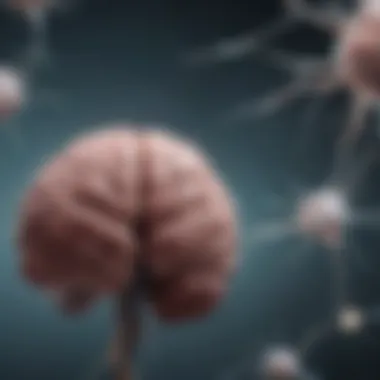Mapping Brain Activity: Insights from the Initiative


Intro
Understanding the brain’s activity is crucial for many fields of science and medicine. The Brain Activity Map initiative stands as a landmark effort in this pursuit. It aims to create a comprehensive map that captures the dynamic nature of brain functions across various conditions. This project is not merely an academic exercise; it has the potential to transform not only how we view the brain but also how we approach treatment for neurological disorders.
As we delve into this initiative, it focuses on key research findings. The findings shape our understanding of neural networks and open doors to new methodologies in cognitive and clinical neuroscience. Moreover, this venture raises ethical considerations that must be addressed as we gain deeper insights into brain functions.
The journey to understanding complex brain activity starts with mapping out the crucial concepts and recent discoveries. This article aims to provide clarity on these topics, enriching our comprehension and driving forward the conversation in neuroscience.
Preamble to the Brain Activity Map Initiative
The Brain Activity Map Initiative emerges as a pivotal project dedicated to the intricate mapping of brain activity. Understanding how the brain functions is paramount, not only for advancing neuroscience but also for enhancing medical interventions related to cognitive and neurological disorders. This initiative represents a systematic approach that integrates various fields in science and technology, addressing the need for comprehensive data on brain activity.
The importanc of this initiative lies in its potential to unravel complex neuronal interactions. Mapping brain activity can illuminate how different regions cooperate during various tasks. It offers a deeper understanding of both normal and altered brain functions, which is crucial for developing effective treatments.
A significant benefit of the Brain Activity Map Initiative is its ability to foster interdisciplinary collaboration. It connects researchers from different domains, combining expertise in neuroscience, computer science, and engineering. Such collaborations can lead to innovative tools and methods for brain mapping.
Moreover, this endeavor raises vital considerations related to ethics and data privacy. As researchers gather extensive data on brain activity, responsible handling becomes key. The implications of mapping not only guide research but can also shape public understanding of brain function and health.
"Mapping brain activity offers exciting possibilities but also challenges us to think critically about how we use such information."
In summary, the Brain Activity Map Initiative is not just a quest for data but a comprehensive effort that could redefine our knowledge of the brain. Understanding this initiative is essential for grasping the future landscape of neuroscience and its applications.
Key Concepts in Neuroscience
Understanding the intricacies of brain activity is essential for grasping the overarching aims of the Brain Activity Map initiative. This section outlines fundamental concepts, including neurons, neural networks, and various types of brain activity. Each element provides a framework that illuminates brain functions and their complex interrelationships.
Neurons and Neural Networks
Neurons are the building blocks of the nervous system. They transmit signals through electrical impulses and chemical signals. Each neuron connects with thousands of others, forming intricate networks that facilitate communication across different brain regions. The health and functionality of these networks are crucial in mapping brain activity. Understanding neural pathways allows researchers to identify how specific areas of the brain work together in various cognitive tasks and emotional responses.
Moreover, the study of neural networks has implications for cognitive neuroscience, particularly in understanding disorders such as autism, schizophrenia, and epilepsy. By studying these connections, the Brain Activity Map initiative can help develop intervention strategies tailored to specific dysfunctions in neural pathways.
Types of Brain Activity
Brain activity can be categorized into three main types: electrical activity, neurochemical activity, and functional connectivity. Each type offers unique insights into the brain's workings and informs the methodologies used in the Brain Activity Map initiative.
Electrical Activity
Electrical activity describes the bioelectrical signals generated by neurons during communication. This activity is measured through various techniques, including EEG. Its key characteristic is the speed at which it can measure neural firing, making it a vital tool for studying immediate responses to stimuli.
Furthermore, electrical activity provides valuable real-time data, which helps in capturing transient states of the brain during tasks. However, its limitations include a relatively low spatial resolution, which can make it challenging to pinpoint specific locations of neural activity with precision.
Neurochemical Activity
Neurochemical activity refers to the release and utilization of neurotransmitters that play a role in communication between neurons. One noteworthy aspect of this type of activity is its capacity for long-term signaling, influencing mood, cognition, and behavior.
Neurochemical activity can also be assessed through methods such as positron emission tomography (PET). Its advantage lies in the ability to observe changes in brain chemistry in response to various conditions. However, the challenge with interpreting this activity is the complexity of its interactions, as multiple factors can influence neurotransmitter systems.


Functional Connectivity
Functional connectivity examines the temporal correlation between different brain regions during rest or during specific tasks. This aspect helps to understand how different brain areas communicate and work in harmony. The key characteristic of functional connectivity is its focus on detecting networks rather than isolated activity, which can provide insights into abnormal interactions in neurodegenerative diseases.
A unique feature is that it allows for the investigation of how functional networks adapt in response to learning and experience. However, interpreting these connections requires sophisticated analytical methods, as findings can sometimes be confounded by noise or artifacts in the data.
"Understanding these core concepts lays the groundwork for advancements that the Brain Activity Map initiative can achieve in clinical practices and cognitive understanding."
In summary, a comprehensive understanding of neurons, neural networks, and various types of brain activity is pivotal in realizing the goals of the Brain Activity Map initiative. Each concept brings essential insights that can foster advancements in neuroscience, contributing to broader applications and deeper knowledge of brain functions.
Technological Innovations in Brain Mapping
Technological innovations play a crucial role in advancing the understanding of the brain through mapping its activity. These tools and techniques not only improve the resolution of brain images but also provide insights into the brain's dynamic functions. The integration of various technologies enables researchers and clinicians to study brain activity in real-time and across different states, which is vital for unraveling the complexities of neural processes and disorders.
Imaging Techniques
Magnetic Resonance Imaging (MRI)
Magnetic Resonance Imaging, or MRI, is an essential tool in brain mapping. It allows for detailed images of brain structures without the need for surgery or ionizing radiation. The key characteristic of MRI is its ability to produce high-resolution images of anatomical features. This makes it a popular choice for both research and clinical applications. MRI's unique feature lies in its capability to detect changes in blood flow and tissue, which are vital for understanding various neurological conditions.
The advantages of MRI include its non-invasive nature and excellent soft tissue contrast. However, it has drawbacks, such as high cost and limited accessibility in some regions, making it less ideal for certain large-scale studies.
Functional MRI (fMRI)
Functional MRI, or fMRI, is a method that measures and maps brain activity by detecting changes associated with blood flow. This technique highlights brain areas that activate during cognitive tasks, providing a beneficial insight into brain function. The key characteristic of fMRI lies in its ability to visualize brain activity in real-time, which is critical for understanding how different brain regions interact during various mental processes.
One unique feature of fMRI is its capability to capture dynamic changes in brain activity over time. This helps in revealing how the brain copes with tasks or stimuli. However, challenges include the need for complex analysis and the risk of misinterpreting data due to movement artifacts.
Electroencephalography (EEG)
Electroencephalography, or EEG, is a technique that records electrical activity of the brain through electrodes placed on the scalp. It provides a key characteristic of high temporal resolution, making it excellent for tracking brain activity on a millisecond scale. This attribute makes EEG a beneficial option in studies involving real-time monitoring of cognitive processes, especially in clinical settings.
The unique feature of EEG is its ability to detect rapid electrical events, providing insight into brain timing and rhythms. However, it has disadvantages such as lower spatial resolution compared to imaging techniques like MRI, making it harder to pinpoint exact locations of brain activity.
Advanced Electrophysiological Methods
Advanced electrophysiological methods enhance our ability to explore the inner workings of the brain. These techniques allow for the collection of precise data on neuronal activity. Innovations like optogenetics and multi-electrode arrays can record and manipulate neuronal firing patterns with great specificity.
Such methods facilitate a more profound understanding of neural circuits and their role in various behaviors and cognitive functions. Research employing these advanced tools has the potential to unlock new avenues in both basic and applied neuroscience, ultimately aiding in the development of targeted therapies for neurological disorders.
Modeling Brain Activity
Modeling brain activity is a critical component of neuroscience that seeks to understand the complex interactions within the brain. This initiative emphasizes the need to develop sophisticated models that can simulate brain functions and predict responses to various stimuli. Such models are not just theoretical; they have real-world applications in clinical settings and contribute to cognitive neuroscience. By using computational methods, researchers can gain insights that were previously unattainable.
These computational models allow for the exploration of how different parts of the brain communicate and function together. They aid in understanding diseases and disorders, providing a framework to predict how alterations in neural pathways can affect behavior and cognition.
Computational Models


Computational models are mathematical frameworks that replicate brain functions. They can range from simple to complex systems, offering a spectrum of insights. The significance of computational models lies in their ability to integrate a vast amount of data available from neural activity studies.
Several types of computational models exist. Examples include:
- Neural network models, which simulate how neurons communicate with each other.
- Biophysical models, focusing on the physical properties and the dynamic processes of individual neurons.
- Agent-based models, which simulate the interactions among agents (neurons) to observe emergent behaviors.
Through these models, researchers can manipulate variables to study the effects on brain activity. They serve as tools for hypothesis testing, as well as for understanding the underlying mechanisms of brain disorders.
Data Integration and Analysis
Data integration and analysis is essential in making sense of the vast amounts of neural data collected from various mapping techniques. The data generated from imaging methods such as fMRI, EEG, and others can be complex and multifaceted. Therefore, it becomes crucial to develop efficient strategies for synthesizing this data.
The integration process involves combining datasets from different sources, which can include:
- Imaging data from functional scans.
- Electrophysiological recordings that provide insights into electrical activity.
- Neurochemical data, which indicates the presence of specific neurotransmitters.
Analyzing this integrated data allows researchers to construct more accurate models of brain activity. Advanced statistical techniques and machine learning algorithms are frequently employed to analyze patterns and correlate findings. By doing so, studies can yield insights into functional connectivity within brain networks.
Applications of the Brain Activity Map
The applications of the Brain Activity Map are vast and crucial in the current landscape of neuroscience. This initiative aims not merely at understanding the components of the brain but also at translating that understanding into practical and impactful solutions. There are several specific areas where the findings from this initiative can greatly benefit both science and society.
Clinical Neuroscience Advancements
One of the primary applications of the Brain Activity Map Initiative is in clinical neuroscience. Mapping brain activity can lead to significant advancements in diagnosing and treating neurological disorders. Here are key ways this initiative impacts clinical practice:
- Precise Diagnosis: By understanding the dynamic interactions within neural circuits, clinicians can develop more accurate diagnostic tools for conditions like epilepsy, schizophrenia, and Alzheimer’s disease. Advanced imaging techniques, informed by the mapping initiative, can reveal changes in brain activity that correlate with specific symptoms, leading to tailored treatment approaches.
- Personalized Treatment Plans: As brain activity maps improve, they allow for the customization of therapies. For example, through this mapping process, neuroscientists can refine stimulation techniques in treatments such as transcranial magnetic stimulation (TMS) or deep brain stimulation (DBS) to match individual brain activity patterns. This precision enhances the efficacy of treatments while reducing side effects.
- Neurorehabilitation Technologies: Developing comprehensive maps of brain activity also fosters the innovation of neurorehabilitation technologies. This can benefit patients recovering from strokes or traumatic brain injuries. Real-time feedback based on brain activity can guide rehabilitation exercises, helping patients regain lost functions more effectively.
- Drug Development: Understanding the exact activity signatures associated with various brain disorders opens new frontiers in pharmacology. Researchers can develop drugs targeted to specific neural pathways, potentially reducing trial-and-error in medication adjustments and enhancing the therapeutic outcomes for numerous neurological conditions.
The significance of these advancements cannot be overstated. As the Brain Activity Map Initiative unfolds, its findings could redefine clinical practices and improve the quality of life for many.
Cognitive Neuroscience Insights
The implications of the Brain Activity Map extend into cognitive neuroscience as well, offering unparalleled insights into how the brain processes information. Through these insights, researchers can explore:
- Cognitive Processes: A deeper understanding of brain activity patterns facilitates the study of cognitive processes such as learning, memory, and decision-making. By analyzing which areas of the brain are activated during these processes, researchers can link specific behaviors to neural mechanisms.
- The Nature of Consciousness: This initiative may provide new perspectives on consciousness. By mapping active neural circuits during various states of awareness, researchers can ask fundamental questions about how consciousness arises from brain activity. This could form the basis for understanding distinct psychological conditions linked to alterations in conscious experience.
- Behavioral Neurology: Insights from the Brain Activity Map can enhance the field of behavioral neurology. It can elucidate how brain activity is influenced by social interactions and environmental contexts. This has implications for understanding disorders like autism spectrum disorder or attention deficit hyperactivity disorder, where social behavior and cognition intersect.
- Neuroplasticity: Mapping brain activity aids in understanding neuroplasticity—the brain's ability to change and adapt. It sheds light on how experiences and interventions can reshape brain activity patterns. This knowledge is invaluable for enhancing educational practices and designing interventions for optimizing learning.
"The mapping of brain activity can illuminate the complexities of human cognition and emotion, leading to groundbreaking discoveries that reshape our understanding of the mind."
In summary, the applications of the Brain Activity Map are a gateway to monumental advancements in both clinical and cognitive neuroscience. The knowledge derived from this initiative has transformative potential, not only in therapeutic practices but also in enhancing our overall understanding of the brain's intricate workings.
Ethical Considerations in Brain Mapping
The exploration of brain activity through advanced mapping techniques brings with it various ethical considerations that cannot be overlooked. The Brain Activity Map Initiative and similar projects promise to unlock new insights into neural functioning, offering both potential benefits and challenges. Delving into these ethical implications is crucial to ensure responsible advancement in neuroscience and to safeguard the rights of individuals involved in research.
Privacy and Data Security
Privacy plays a vital role in the conversation around brain mapping technologies. As these initiatives gather sensitive data from participants, it becomes essential to implement rigorous safeguards to protect this information. The data derived from brain activity mappings can include personal identifiers and sensitive health information. This raises profound concerns about who has access to this data, how it is stored, and what measures are in place to prevent unauthorized access.


- Informed Consent: Participants must be informed about how their data will be used. Failure to obtain informed consent can lead to ethical dilemmas in research.
- Anonymization Procedures: Adequate anonymization of data can help mitigate risks linked to privacy breaches. Techniques must be robust to ensure identity protection.
- Data Security Protocols: Advanced encryption and secure databases are critical to safeguard sensitive information against cyber threats.
- Regulatory Compliance: Adhering to laws such as the Health Insurance Portability and Accountability Act (HIPAA) in the United States is essential to maintain ethical standards in data handling.
Implementation of solid privacy and security measures enhances trust in research initiatives. This trust encourages greater participation, ultimately advancing the field of neuroscience.
Implications for Mental Health
The insights gained from mapping brain activity may offer groundbreaking implications for mental health. However, the ethical dimensions surrounding these advancements merit careful consideration. People struggling with mental health issues can benefit from improved understanding of their conditions through precise brain activity mapping. Yet, several ethical concerns arise in this context.
- Potential Misuse of Data: There is a risk that data could be misinterpreted or misused in ways that could stigmatize individuals or lead to discrimination.
- Overdiagnosis and Labeling: There might be a tendency to overdiagnose based on the outputs of mapping technologies, leading to unnecessary treatment or labeling of individuals.
- Access to Treatment: If brain mapping leads to new treatments, questions arise about who will have access to these therapies and how equitable the distribution can be.
- Patient Autonomy: The possibility of using brain mapping for mental health diagnoses raises concerns about patient autonomy. Patients should have a say in how technologies are utilized for their diagnosis and treatment.
In summary, navigating the myriad ethical dimensions of brain mapping is an essential endeavor. By focusing on privacy concerns and the implications for mental health, we can ensure that the advancements foster positive outcomes while minimizing risks and ethical quandaries. Addressing these issues proactively lays the groundwork for responsible scientific inquiry.
Future Directions in Brain Activity Mapping
The exploration of brain activity mapping is entering a crucial phase. As researchers strive to decode neural processes, understanding the future directions of this field becomes fundamental. Emerging technologies and collaborative efforts will play pivotal roles in shaping our understanding of brain function. The implications of these advancements stretch beyond academic research, influencing clinical practices and broader societal perceptions of mental health.
Interdisciplinary Collaborations
Interdisciplinary collaborations form the backbone of progress in brain activity mapping. By merging expertise from fields such as neuroscience, engineering, computer science, and psychology, a more comprehensive approach can be developed. Each discipline brings unique insights and methodologies. For example, engineers can enhance imaging technologies, while neuroscientists provide detailed knowledge about brain structures and functions.
Projects like the Brain Activity Map Initiative thrive on this synergy. Collaborative efforts have already led to breakthroughs in imaging techniques and data analysis. They foster innovation that pushes the boundaries of current research.
"Collaboration across disciplines not only enhances research output but also leads to transformative discoveries that are crucial for understanding complex brain functions."
Such partnerships will help address the multifaceted challenges of mapping brain activity. They encourage diverse perspectives that enhance problem-solving, ultimately leading to more robust scientific outcomes.
Potential Impact on Society
The potential impact of improved brain activity mapping on society is profound. As research becomes more refined, the knowledge gleaned from brain mapping will inform treatment protocols for various neurological and mental health conditions. For instance, personalized medicine could become a reality, with treatments tailored to individual brain activities.
In addition to clinical applications, there is a broader societal dimension to consider. As awareness grows regarding brain function and mental health, social stigmas may diminish. Education about brain activity can promote a better understanding of mental health issues, paving the way for healthier societal perspectives.
This shift can lead to increased funding for research and more emphasis on mental health initiatives. Awareness campaigns could harness the growing body of knowledge about brain functions to inform the public and policymakers alike.
Finale
Understanding the conclusion of the Brain Activity Map initiative reinforces its significance in the contemporary landscape of neuroscience. The initiative serves as a pivotal juncture, merging innovative technology with profound insights into brain functions. This program not only aims to map the brain's intricate activity but also to unveil the underlying principles governing neural connectivity. The resultant framework holds immense promise for advancing both basic and applied neuroscience across various domains.
Summarization of Key Findings
In reflecting upon the pivotal elements derived from this investigation, several key findings emerge:
- The Brain Activity Map initiative is grounded in interdisciplinary collaboration, fostering teamwork among neuroscientists, engineers, computer scientists, and ethicists.
- It has introduced cutting-edge imaging techniques such as fMRI and EEG, allowing for real-time observations of brain activity.
- The initiative highlights the importance of data integration, enhancing the understanding of how different brain regions coordinate dynamically.
- Through its broad implications, the initiative signals potential advancements in treating neurological disorders and improving cognitive health.
The integration of diverse technological tools in brain mapping could redefine our approach to understanding cognitive functions and mental health.
Open Questions and Research Gaps
Despite the promising landscape shaped by the initiative, there remain numerous unanswered questions and gaps warranting further research:
- How will emerging technologies like machine learning enhance the analysis of complex neural patterns?
- What ethical considerations must be navigated as more detailed maps of brain activity are developed?
- Are there limitations in current methodologies that could hinder the full understanding of brain interactions?
- How can researchers ensure the privacy of individuals whose brain activity is being mapped in studies?
The endeavor to create a comprehensive understanding of brain activity is ongoing. Each question and gap identified marks a path for future exploration and a call for further dialogue among scholars, practitioners, and ethicists in the field.















